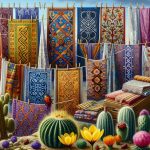Imagine fabric dyeing as a thread that weaves through the tapestry of human history. You'll find that ancient civilizations relied on natural dyes from plants, minerals, and insects to create vibrant textiles. These early techniques, involving mordants and boiling methods, didn't just aim for color but held cultural significance too. Fast forward to the Industrial Revolution, and synthetic dyes began to change the game, both regarding color consistency and environmental impact. But what about today's practices and the push for eco-friendly solutions? It's a journey worth exploring.
Table of Contents
Key Takeaways
- Ancient civilizations used natural dyes from plants, minerals, and insects for vibrant and eco-friendly fabric coloring.
- The introduction of synthetic dyes in 1856 by William Henry Perkin revolutionized fabric dyeing with consistent and brilliant colors.
- Fabric dyeing techniques shifted from artisanal methods to mass production during the Industrial Revolution, impacting efficiency and environmental sustainability.
- Traditional dyeing methods employed natural mordants and boiling techniques to ensure colorfastness and cultural significance.
- Eco-friendly practices in modern dyeing emphasize using natural dyes to reduce environmental impact and promote sustainable textiles.
Ancient Dyeing Practices
Throughout history, ancient civilizations frequently used natural dyes from plants, minerals, and insects to color their fabrics. If you want to master the art of fabric dyeing, it's essential to understand these ancient dyeing practices, which were rich in traditional techniques and cultural significance.
Ancient societies didn't just dye fabrics for aesthetics; they imbued their textiles with cultural stories and symbols, making each piece a tribute to their heritage.
You'll find that these practices relied heavily on ancient dye sources like indigo, madder root, and cochineal insects. These sources weren't only effective but also sustainable, as they were readily available and renewable.
Ancient dyers practiced sustainable methods, ensuring that their dyeing processes didn't harm the environment. For example, they often used mordants derived from natural minerals to fix the dyes, enhancing the color's longevity without resorting to harmful chemicals.
Natural Dyes
You'll find that natural dyes have roots in ancient dyeing methods, often using plant-based sources like roots, leaves, and berries.
These dyes not only offer vibrant colors but also promote eco-friendly dyeing practices.
Ancient Dyeing Methods
Ancient civilizations mastered the art of fabric dyeing using natural dyes sourced from plants, minerals, and insects. They employed traditional techniques that were deeply intertwined with cultural significance. You can appreciate how these methods weren't just practical but also a form of artistic expression and storytelling.
Consider the historical processes used by the Egyptians, who utilized indigo and madder to achieve vivid blues and reds. The Greeks and Romans favored Tyrian purple, derived from sea snails, symbolizing wealth and power. Each culture had its distinct palette and methods, reflecting their environment and societal values.
Here's a table to illustrate some ancient dye sources and their cultural importance:
| Civilization | Dye Source |
|---|---|
| Egyptians | Indigo, Madder |
| Greeks/Romans | Tyrian Purple |
| Chinese | Mulberry Bark |
| Native Americans | Black Walnut Hulls |
These dyes weren't just about color; they held spiritual and symbolic meanings. For instance, Native Americans used black walnut hulls for brown, symbolizing the earth and stability. Techniques like boiling fabrics with mordants guaranteed the colors were vibrant and lasting. By comprehending these ancient dyeing methods, you gain a richer appreciation for the intricate blend of science and art that defines fabric dyeing.
Plant-Based Dye Sources
Plants have long provided vibrant and diverse dyes that continue to be treasured for their natural beauty and sustainability. When you explore the world of plant-based dyes, you'll find a rich tapestry of colors derived from roots, leaves, flowers, and even bark. These dyes aren't just about color; they connect you to time-honored traditions and sustainable practices.
Dye extraction from plants involves traditional methods that have been passed down through generations. For instance, indigo from the indigofera plant requires fermentation, while madder root must be carefully dried and ground. These processes, though labor-intensive, yield rich, lasting hues that synthetic dyes can't duplicate.
Incorporating sustainable practices into dye production is essential. You can harvest plants without damaging their ecosystems, ensuring that dye sources remain abundant. By using renewable plant materials and avoiding harmful chemicals, you not only create beautiful textiles but also contribute to environmental preservation.
Mastering plant-based dyeing means understanding the intricate balance of nature and craftsmanship. Every step, from plant selection to dye extraction, requires knowledge and respect for the environment.
As you explore these natural dyes, you'll discover the profound beauty and sustainability they bring to fabric dyeing.
Eco-Friendly Dyeing Practices
Frequently, eco-conscious dyeing methods harness the power of natural dyes to create beautiful, sustainable textiles. By using plant-based and other natural sources, you can achieve vibrant colors without the environmental impact of synthetic chemicals. These sustainable alternatives promote water conservation, as natural dyeing processes typically require less water and produce fewer pollutants.
To master eco-conscious dyeing, focus on renewable resources. Plants like indigo, madder, and turmeric are excellent choices because they can be cultivated and harvested seasonally, guaranteeing a continuous supply. By integrating these materials, you actively contribute to waste reduction, as natural dyes often utilize by-products from other industries, such as food processing and agriculture.
Incorporating natural dyes into your practice not only promotes sustainability but also guarantees the creation of unique, high-quality fabrics. You'll find that the colors derived from natural sources often possess a depth and complexity that synthetic dyes can't match. By embracing these techniques, you're not only enhancing your craft but also supporting a healthier planet.
Medieval Dyeing Methods
During the medieval period, artisans utilized a variety of natural sources and intricate techniques to produce vibrant fabric dyes. To master these historical dyeing techniques, you'd need to familiarize yourself with medieval dyeing recipes and the specific dyeing tools used.
Artisans depended on plant, animal, and mineral sources to achieve a wide range of fabric colors. Common materials included:
- Madder Root: Produced rich reds.
- Woad Leaves: Yielded a distinct blue.
- Weld Plant: Created bright yellows.
- Cochineal Insects: Provided intense carmine hues.
The process often began with preparing the fabric using a mordant, a substance that helps dyes bind to the textile fibers. Alum, iron, and tannin were popular mordants, each impacting the final shade.
To practice these methods, you'd immerse the fabric in a dye bath, continuously stirring to guarantee even color distribution. The duration and temperature of the bath were crucial, influencing the depth and vibrancy of the hue.
These artisans didn't just rely on natural sources; they meticulously documented their medieval dyeing recipes, passing them down through generations. Mastery of these techniques required understanding the interaction between various dyeing tools and natural dyes, ensuring the creation of long-lasting, brilliant colors.
Industrial Revolution Impact
During the Industrial Revolution, a seismic shift in fabric dyeing occurred with the emergence of synthetic dyes.
These new dyes, along with mass production methods, revolutionized the textile industry.
Fabric could now be dyed more quickly, consistently, and in a wider array of colors than ever before.
Synthetic Dyes Emergence
The Industrial Revolution introduced synthetic dyes, revolutionizing the fabric dyeing industry with vibrant, long-lasting colors. This was a time of significant chemical innovations, which led to the development of dyes that far outperformed their natural counterparts. These breakthroughs, however, came with environmental concerns, as the processes involved often released harmful substances into waterways.
You'll find that synthetic dyes opened new doors for artistic expressions, allowing for a broader palette of hues and shades that were previously unattainable. This had a profound impact on cultural influences, as different societies began to embrace and integrate these vivid colors into their textiles, clothing, and art.
Imagine the transformation through these key developments:
- Chemical Innovations: The creation of the first synthetic dye, mauveine, by William Henry Perkin in 1856, marked the beginning of an era where chemistry and textiles would be forever intertwined.
- Environmental Concerns: Factories discharging untreated dye waste led to polluted rivers and health hazards, spotlighting the need for sustainable practices.
- Artistic Expressions: Artists and designers could now experiment with a wider range of colors, pushing the boundaries of creativity.
- Cultural Influences: Societal trends shifted as these new, brilliant colors became integrated into everyday life, influencing fashion and decor.
Mass Production Methods
With the advent of the Industrial Revolution, fabric dyeing techniques evolved dramatically, embracing mass production methods that forever changed the textile industry. You witnessed a shift from artisanal, labor-intensive dyeing to streamlined, automated processes. This evolution brought about significant efficiency improvements, allowing fabric to be dyed in vast quantities with remarkable uniformity.
Automation played a pivotal role in this transformation. Machines handled repetitive dyeing tasks with precision, reducing human error and labor costs. The chemical processes introduced during this era enabled the use of synthetic dyes, which were more consistent and vibrant than natural dyes. However, these advancements came with a notable environmental impact. The mass use of synthetic dyes and chemicals resulted in pollution and waste that affected ecosystems.
Here's a brief comparison of pre- and post-Industrial Revolution dyeing:
| Aspect | Pre-Industrial Revolution | Post-Industrial Revolution |
|---|---|---|
| Scale of Production | Small-scale, artisanal | Large-scale, industrial |
| Labor | Manual, labor-intensive | Automated, less manual labor |
| Dye Consistency | Variable, natural dyes | Uniform, synthetic dyes |
| Environmental Impact | Minimal, natural sources | Significant, chemical pollution |
Mastering these historical shifts helps you appreciate the balance between technological progress and its environmental repercussions.
Synthetic Dyes Emergence
A revolutionary shift in fabric dyeing began when synthetic dyes were first developed in the mid-19th century. This period coincided with the industrial revolution, a time when technological advancements in chemical processes transformed various industries.
The discovery of the first synthetic dye, mauveine, by William Henry Perkin in 1856 marked the dawn of a new era in textile dyeing. Synthetic dyes offered vibrant, consistent colors that natural dyes couldn't match, revolutionizing the industry.
As you explore the emergence of synthetic dyes, consider these key aspects:
Chemical Innovation: The creation of synthetic dyes required advanced chemical processes, reflecting the scientific prowess of the era.
Color Consistency: Synthetic dyes provided unwavering color consistency, which was a significant improvement over the variability of natural dyes.
Scalability: These dyes could be produced on a large scale, aligning perfectly with the mass production methods introduced during the industrial revolution.
Economic Impact: The shift to synthetic dyes dramatically reduced production costs, making colorful fabrics accessible to a broader market.
Modern Dyeing Techniques
Today, modern dyeing techniques blend innovation and sustainability, transforming how fabrics are colored. You'll find that sustainable innovations are at the forefront of this transformation. Technologies like low-water dyeing and the use of biodegradable dyes are reducing the environmental footprint of the textile industry. These methods not only save water but also minimize waste, ensuring that the dyeing process is more eco-friendly and efficient.
Moreover, digital printing is revolutionizing fabric dyeing by offering precision and versatility. Unlike traditional methods, digital printing allows you to transfer intricate designs and vivid colors directly onto fabrics using specialized inkjet printers. This technique reduces the need for excess dye and water, aligning perfectly with sustainable practices.
Additionally, it provides you with the flexibility to create custom patterns and short-run productions without the high costs and waste associated with conventional dyeing.
Eco-Friendly Dyeing
Eco-conscious dyeing methods are transforming the textile industry by prioritizing sustainability and reducing environmental impact. If you're passionate about mastering eco-friendly practices, you'll find these methods both innovative and essential. Embracing sustainable alternatives not only conserves resources but also safeguards the health of our ecosystems.
Here are four key techniques revolutionizing eco-friendly dyeing:
- Natural Dyes: Extracted from plants, insects, and minerals, these dyes offer vibrant hues without harmful chemicals. Consider indigo from leaves or deep reds from cochineal insects.
- Low-Impact Dyes: These synthetic dyes require less water and energy, producing minimal waste. They're designed to bond more efficiently with fibers, reducing runoff.
- Waterless Dyeing: Innovative technologies like CO₂ dyeing eliminate the need for water entirely. Envision dyeing fabrics using pressurized carbon dioxide, significantly reducing water usage.
- Bio-Based Dyes: Derived from renewable resources, these dyes are biodegradable and non-toxic. Imagine using algae or bacteria to achieve stunning colors without the drawbacks of conventional methods.
Frequently Asked Questions
What Are the Safety Precautions for Handling Dyeing Chemicals at Home?
When handling dyeing chemicals at home, maintain proper ventilation, wear protective gear, and use eye protection. Prevent spills by working carefully. These precautions help you maintain safety and avoid accidents during your dyeing projects.
How Can Fabric Dyeing Impact Skin Allergies?
When fabric dyeing, you should consider skin sensitivity. The dyeing process can cause allergic reactions if you're exposed to certain chemicals. Always use gloves and test dyes on a small skin area first.
What Are the Differences Between Dyeing Natural and Synthetic Fabrics?
Did you know that synthetic fabrics often absorb 60% less dye than natural ones? The dyeing process and application techniques vary greatly, affecting color absorption and fastness properties, ultimately determining the vibrancy and longevity of your fabric.
How Does Water Quality Affect Dyeing Results?
You need to think about water quality because it directly impacts dye absorption. The effects of pH levels in your water can alter the final color and consistency, making it essential to test and adjust accordingly.
Can Fabric Dyeing Be Done Using Household Items?
Yes, you can dye fabric using household items. Experimentation with natural dyes like turmeric or onion skins can make for creative projects. Try tie dye techniques with these materials for vibrant, unique results.
- How Does Ring Spun Cotton Affect Garment Fit and Shape Retention? - August 13, 2024
- What Are the Challenges in Producing Ring Spun Cotton? - August 13, 2024
- Is Ring Spun Cotton Suitable for Plus-Size Clothing? - August 13, 2024





